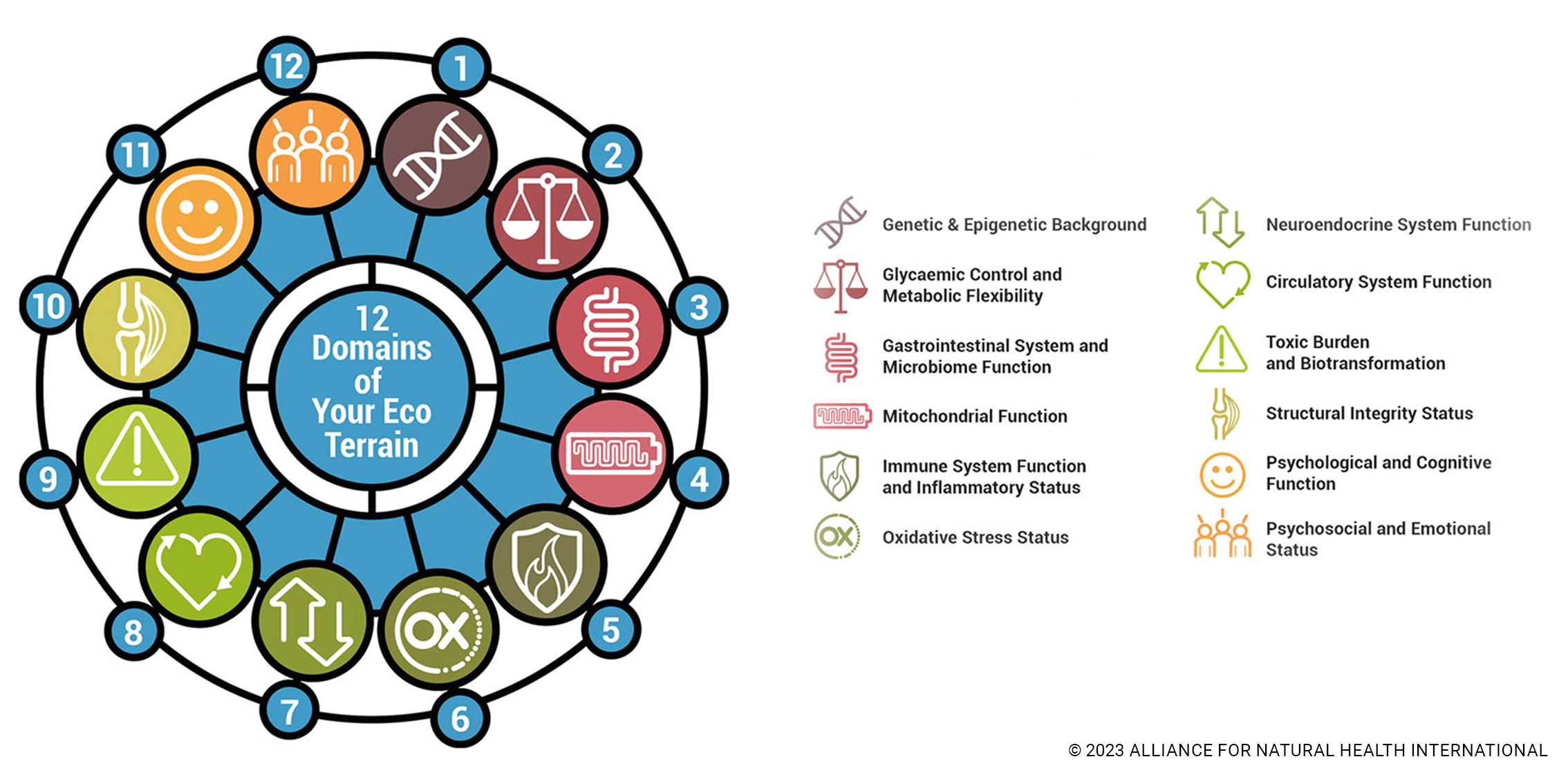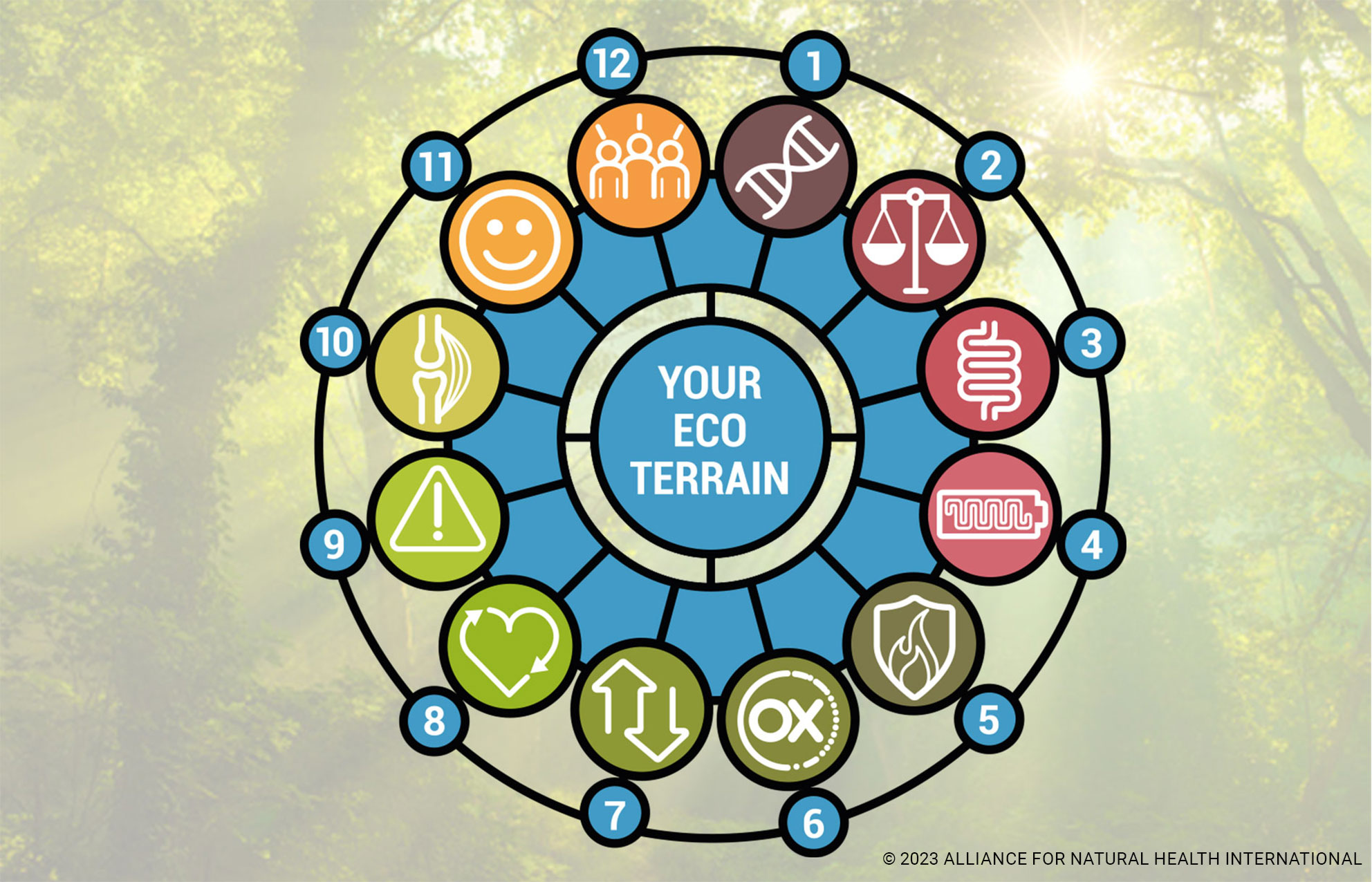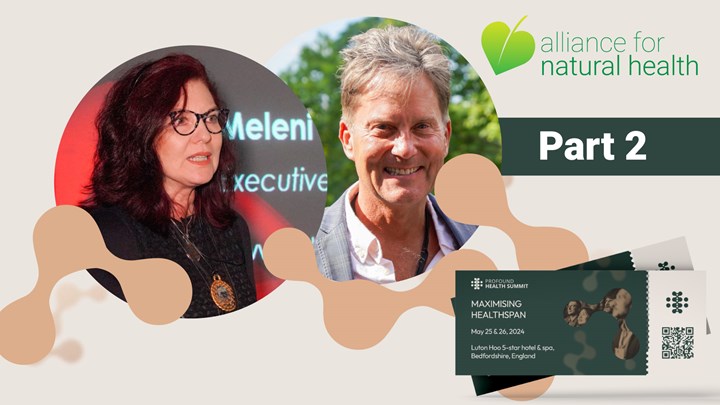Content Sections
The development of modern medicine and the application of Western reductionist thinking means most people think of the body in terms of its discrete organs and systems that largely reflect the specialisms in medicine (e.g. immune, endocrine, circulatory, neurological systems). But putting parts of our bodies into individual silos negates the interconnectedness between these systems. More than this, it ignores something that’s even more important: the interaction of the whole organism with its internal and external environment. That’s of course something that goes beyond medicine in the way it’s typically practiced in the West. It involves biology and ecology.
In this article, we answer 5 important questions about the Ecological Terrain, one of the central elements that we use in our blueprint for health system sustainability, to better understand human function.
Why is ecology so important to us?
Human beings, just like all other living organisms that have yet to become extinct, have managed to adapt over millennia to dynamic internal and external environments that include an incredible array of biotic (living) and abiotic (non-living) factors. Those human populations that experience the lowest rates of disease and longest life spans – as identified in the ‘blue zones’ – all follow approaches to health and its care that are holistic in nature. They all understand the inherent interconnectedness of stable and resilient living systems, and the consequences when some of these systems become disconnected. The modern day health scourges that now threaten to sink health delivery systems in the industrialised world are – to a large extent – symptoms of this disconnection. That involves disconnection from nature, from our gut microbiota, from each other, and from the natural world around us. Technology has done some extraordinary things to get us this far, but it’s interesting that, so far, there’s little evidence that technology directly creates or regenerates health.
Thanks to Sir David Attenborough and others, many now understand well the interconnectedness between organisms in the natural world. Humans, on the other hand, very often like to see themselves as separated. If not superior, at least different. Of course, all animals are unique, and while we like to think it’s our intelligence, creativity and resourcefulness that sets us apart, there are many examples of extraordinary intelligence, creativity and resourcefulness shown by other species. Sir David will attest to that. As uncomfortable as it might be to recognise, it is perhaps our capacity to so catastrophically alter the natural environment in our bid to separate ourselves from it, often through our use of technology, that makes us so unusual. It is the inability of politicians to put these issues near the top of their agendas that has spawned the Extinction Rebellion movement that has brought London and other cities to a standstill in the last couple of days.
What’s the Ecological Terrain?
Humans are exceptionally complex, genetically and epigenetically unique organisms. Within us are thousands, even millions, of interlinked processes and systems. These form the terrain, the ‘ground’ on which we’re built.
Ecology refers to the unique and individual relationships and interactions between ourselves, our external and internal environments and the organisms such as bacteria and viruses that live both in, on and around us.
The Ecological Terrain is where our terrain and ecology meet. Forming a system of 12 distinct yet interconnected areas (domains), health care should aim to balance each of these domains to allow the optimal function of the individual within its community or environment. When all 12 domains are in balance, the opportunity for disease to manifest is removed. When one or more domains is found to be out of balance, assuming it's picked up early enough, balance can be re-established before the imbalance turns to disease.
Why 12 domains?
Health is dependent on function – and function is the result of multiple, not single, systems working together in coordinated ways. So, for example, blood sugar regulation, which is vital to our survival, doesn’t just involve one system or one hormone, say insulin. It includes how we regulate our consumption of food, what, when and how we eat, how our appetite is regulated, what environments we live in, what others around us do, how we digest foods, how our central and autonomic nervous systems respond and what our endocrine system does through the regulation of hormones like insulin and glucagon and pathways like mTOR and AMPK. Yes, it gets complicated. But we now have potent markers of function that we can use for all 12 of the domains. So our selection of the 12 domains is about looking at the most fundamental systems in the body and matching those to state-of-the-art science, validated biomedical markers. More than that, we’ve also identified lower cost, more subjective approaches to measuring the function of each of the 12 domains so that nobody is excluded when the biomedical test in question isn’t yet recognised by healthcare or insurance systems that are still marching to the tune of an outmoded, pharmaceutical-dependent biomedical model.
The 12 domains give each one of us a framework within which to collect data and information about our health status and function. Built into the ‘blueprint’ are three discrete levels of evaluations, namely self-evaluation by an individual, guided evaluation (where health and/or fitness professionals help interpret self-recorded data) or practitioner evaluation through use of biomedical testing and evaluation methods that generally need to be ordered by and interpreted by a qualified health professional.
Using a common language across all modalities of medicine – as well as among fitness and other health-related professionals – allows individuals, with or without the guidance of health-related professionals of their choosing, to work to maintain or restore balance across all 12 domains.
The 12 domains of the Ecological Terrain are shown below:

Breaking new ground with the Ecological Terrain
The blueprint brings a new paradigm to the way we think about our health and how we manage and treat it. Setting the scene through the Ecological Terrain, we then apply the principles of sustainability to take us from a system primarily aimed at finding and treating disease to one that promotes upstream health creation and, in the process, significantly reduces the incidence of downstream, preventable diseases.
How can you use the Ecological Terrain for your benefit?
Being able to understand which one of 12 domains in your body and environment isn’t functioning properly allows you to prioritise the changes you need to make to bring your body back to optimal function. Having a common language allows more effective and clear communication between you and your chosen health care and/or fitness professionals.
Find out more
Full details of ANH-Intl’s unique recommendations for the future of health care can be found on our Great Health Reset campaign page.








Comments
your voice counts
20 April 2019 at 9:49 am
Only the naive and gullible will not see that 'identity politics' or manipulation via mind capture also operates through the 'environmental' movement as 'useful idiots' not in terms of their intelligence - but in the framing of its application.
Toxicity, like hate or cultivation of fear, engineering of scarcities as a means of control, is against the living and as you rightly identify - undermining of functional existence - which includes the quality of consciousness free of fear and open to wholeness of being.
Wholeness of being is another term for real relationship - as opposed to managed compartmentalism under tyranny of a system of targets and checkboxes - where the targets can be manipulated by the setting up of fears in the collective that then demand 'change' or of 'expert' diagnosis that are used as a COMPELLING dictate for top down mandates that abnegate freedom in violation of choice in a context of relational honesty and extended trust. These are 'digitised' to such terms as 'vaccine hesitancy' or expressed as if a malady or psychiatric 'disease' to be 'treated'. Non compliance becoming 'denialism'.
Society and Politics runs on the Big Lie - and that is a breakdown of our Worldview or in some sense our identity, to uncover. But until we do open a true discernment, we run under the current spell of manipulative illusions - not least because to open a true responsibility for wholeness of being must look upon and look past the false usurping of mind and life that MUST use the mind to hide itself because it isn't true.
The spiritual nature of our being is purpose. Creating frameworks of 'meanings' that substitute for a true relational environment is using the mind of the Model as a weapon against wholeness, in order to GET more for a self in image.
I feel for the baby in the bathwater of what ANH campaigns - because UN natural frameworks of 'health' work a sickness agenda - in which those who participate get more for their sense of private self interest - and at a deeper level - identity is no less reinforced by 'more' of a negative.
An Era of awakening to healing and awakening in Life is the opening of a true foundation. The active invested identity will seek to interject and subvert this to a revamped version of the same old 'wine bottle' paradigm - because that is the blind function of blocking Communication and health in fear of Life - to instead rule over a sense of private control.
Propaganda is invisible to its believers. Exceptionalism holds double standards without any qualms. Evils or feared outcomes that are NOT here but for allowing fear to manipulate or capture the mind to then ACT as if they are - are used to 'justify' an ongoing allegiance and support to loveless, hateful and toxic agenda.
The deceiver makes the fear AND provides the 'salvation' fro it - as the persistence of a split mind, blind to Life in wholeness or true relation and knowing not what it does.
But the belief one is actively dealing with, escaping, mitigating or managing the fear is the bubble identity within its frame, that invests identity and then protects its investment against true messengers or the opening of a perspective in which the need for hate, unforgiveness or division and diversion is undone.
A key element of which is guilt. The environmental movement CAN be an expression of love or relational being. But in practice it is the targeting and manipulation of environmental guilt as the packaging of toxic debt into complex instruments of privately run top down control.
The mind is easily hacked once induced to fear and division. Apocalyptic fears are existential - and access the maximum override of Reason for the 'saving of a subjection under terror'.
There is global toxicity - but its nature is firstly deceits that make fears and guilts that are targeted as weapons on the living.
Your voice counts
We welcome your comments and are very interested in your point of view, but we ask that you keep them relevant to the article, that they be civil and without commercial links. All comments are moderated prior to being published. We reserve the right to edit or not publish comments that we consider abusive or offensive.
There is extra content here from a third party provider. You will be unable to see this content unless you agree to allow Content Cookies. Cookie Preferences